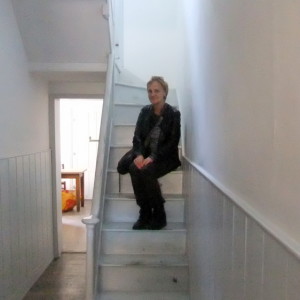Momma's house
My mother's Jewish momma - for that was what her nine children called her. I barely remember her, my grandmother, just as a very old, demented and helpless figure who was looked after by an aunt. And it was only in around 2000 that I dabbled in some family history and discovered that she was born here, at 14 Pelham Street, Spitalfields, in the east end of London, in 1871 (or 2). Leah (or Lena) Kesner (or Kisney, or Kizener) was the youngest child of a Jewish couple from Vilno in Lithuania (then Greater Russia) who arrived here in London's refugee melting pot (between the Huguenot and the Bangladeshi waves of immigration) with their son and three daughters. My grandmother's next sister up had been born in Hamburg, their port of embarkation; Leah was their only British born child.
Pelham Street (now called Woodseer Street) off Brick Lane was built in the mid-19th century: cheap terraced housing for workers in the Spitalfields weaving industry, described (and the street illustrated here) by Charles Dickens' in 1851:
From fourteen to seventeen thousand looms are contained in from eleven to twelve thousand houses... Spitalfields was the Necropolis of Roman London; the Registrar- General’s returns show that it is now the grave of modern Manufacturing London. The average mortality is higher in this Metropolitan district than in any other.
By the time my great grandparents arrived most of the Huguenot weavers had left the area and their homes and jobs were taken over by impoverished Jews who made the rag trade their own. My great-grandfather, a furrier by trade, was employed as a simple cap maker and the three oldest daughters became sweatshop garment-workers. Domestic and working conditions were appalling as people struggled to survive in the over-crowded slums. In 1888 the daughter of the tenant of Number 16 was murdered, along with many other young women who fell victim to the Ripper.
Leah and her sisters all escaped via marriage* into better, more respectable lifestyles but their father died in the German Hospital in Hackney and their mother in Bethnal Green workhouse.. All this family history was suppressed by the subsequent generation and I was well into adulthood before I knew anything about it. But over the last decade or so I have visited Spitalfields many times. Its latest incarnation as a hipster hangout and tourist magnet, where ghost signs are cherished and murals adorn every vacant wall, where independent coffee shops and edgy art galleries abound, leaves me feeling a trifle superior: I can own Spitalfields because my grandmother was born right here at 14 Pelham Street.
Today, as before, I spent a while loitering around this unprepossessing side street and the mysterious shuttered house at No. 14 when a couple approached and unlocked the door... I pounced! Yes, they lived here, would I like to look inside? And wonder of wonders, theirs is the only house in the street that retains its original features. It was derelict when they bought it but they kept the layout downstairs: one front room and a smaller one behind, a tiny kitchen opening into a back yard with two outhouses (for two families who lived here, one upstairs, one down.) And the stairs and wainscoting are exactly as they were when my grandmother was born here 143 years ago.
It seems to me then as if all the moments of our life occupy the same space, as if future events already existed and were only waiting for us to find our way to them at last, just as when we have accepted an invitation we duly arrive in a certain house at a given time. W.G.Sebald
*See here for another part of the story, and again here.
Extra photo added of myself on the stairs.


Comments
Sign in or get an account to comment.


